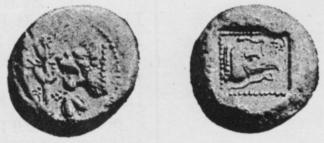
FIG. 384.



Cyrene was founded by Dorians from the island of Thera, under the leadership of one Battus, the ancestor of the dynasty called after him the Battiadae, who ruled the country of the Cyrenaïca from about B.C. 631
Of all the varied products of this beautiful country, the far-famed silphium plant (a form of assafoetida, now extinct) was the most important, and was highly prized through the whole ancient world, both for its medicinal virtues and for the perfumes extracted from its flowers.
The bearded head with the ram’s horn on the coins of Cyrene is that of Zeus Ammon, while the youthful head, also with the ram’s horn, is perhaps intended for Aristaeos, the protected of the corn-field and the vine and of all growing crops and bees and flocks and shepherds, and the averter of the scorching blasts of the Sahara. This beneficent god was the son of Apollo and of the nymph Kyrene, and his cultus in the Cyrenaïca appears to have been closely allied to that of the Libyan Ammon, who was also a pastoral god. The female head, of rarer occurrence, is the nymph Kyrene.
The silphium plant as a Cyrenaean coin-type, like the bee at Ceos (supra, p. 483), may have had a religious origin in connexion with the cult of Aristaeos, cf. Schol. in Aristoph. Eq. 894 ‘Αρισταιος δε, ο ‘Απολλωνος και Κνρηνης, πρωτος την εργασιαν του σιλφιου εζευρεν, ωσπερ και του μελιτος.
The earliest money attributed to Cyrene consists of extremely archaic electrum and silver coins of the Euboic-Attic standard. This seems to point to commercial relations between Euboea and the Libyan coast at a time when the Euboean cities, Chalcis and Eretria, exercised a predominate influence in the eastern basin of the Mediterranean Sea.
The very rare electrum coins which Müller (op. cit.) has attributed to Cyrene may be thus described:—
| Double floral pattern. [Rev. Num., 1894, p. 254, Pl. X. 1.] | Two oblong incuse depressions. EL. 269 grs. |
| Id. [Ibid. Pl. X. 2.] | One square and one oblong incuse. EL. 133.1 grs. |
For other electrum coins conjecturally attributed to Cyrene see B. M. C. Ionia, Pl. I. 2, 12, and p. 6, No. 30.
M. Babelon (Rev. Num., 1885, p. 390 sq., and 1894, p. 254) disputes the attribution of these electrum coins to Cyrene, and would assign them to Asia Minor. He also publishes a coin of pure gold, which may possibly be of Cyrenean origin. It is of the Phoenician standard.
| Four flowers in the angles of a cruciform pattern. | Rough incuse square. AV 110 grs. [Rev. Num., 1885, Pl. XV. 1.] |
The prevailing types of the earliest silver coins (some of which may belong to other cities of the Cyrenaïca) are:—
To these types are sometimes added accessories in the field, such as a lion, a lion’s head, or a boar (Rev. Num., 1885, Pl. XV. 2), &c. The reverses are in this period always incuse without any ornament. The square is sometimes divided diagonally, as on the primitive coins of Euboea, sometimes it is quartered, sometimes divided by a board band into two oblong parts, sometimes filled with narrow lines; there are also certain specimens with a triangular incuse (Z. f. N., xxii, p. 244). For illustrations see Babelon, Traité, ii, Nos. 1973 ff.
For other coins which have been attributed to Cyrene, but which may be of Macedonian origin (running female figure holding flowers, winged figure holding wreath, boar), see Rev. Num., 1885, pp. 393 f.; 1903, p. 311.
The coins which may be assigned to this period are—
| Silphium plant. | Κ Gazelle, silphium plant, and fruit, all in incuse square. AR Tetradrachm. |
| Id. [Müller, i, p. 11, No. 23.] | Silphium fruit between two dolphins, all in incuse square. AR Tetradrachm. |
| Id. [Müller, No. 23.] | Incuse square. Herakles and nymph standing on either side of the tree of the garden of the Hesperides. AR Tetradrachm. |
| Id. [Num. Chron., 1892, p. 19, No. 31.] | Incuse square. Gorgoneion. AR Tetradrachm. |
| Id. [Babelon, Traité, ii, Pl. LXIV. 16.] | Incuse square. Head of Zeus Ammon r. AR Tetradrachm. |
| Nymph Kyrene seated l. with silphium seed behind her. [Num. Chron., 1886, Pl. I. 6.] | Forepart of Pegasos l. in dotted square. AR Tetradrachm. |
| Same type, r. [Rev. Num., 1885, Pl. XV. 5.] | Head of Zeus Ammon r. in incuse square. AR Tetradrachm. |
| Four silphium sproutes in floral pattern, with bearded head, or horse’s head, above. [Bompois, Cyr., i. 6.] | Incuse square, containing floral star. AR Didrachm. |
| Similar, but with horse’s head in place of bearded head. | Incuse square, containing floral star. [Bompois, Cyr., Pl. I. 7.] AR Didrachm. |
| Archaic bearded head with bull’s horn and four or two fruits of the silphium in the field. | Incuse square, containing floral star in incuse circle or square. AR Didr. and dr. |
| Lion’s head facing and silphium fruit. | Incuse square, containing griffin’s head r. AR Drachm.
|
| Fruit of silphium. | Incuse square, containing archaic bearded head (Ammon?) or female head. AR ½ Drachm. |
| Id. | Incuse square, containing winged female figure. AR ½ Drachm. |
| Genet reclining over silphium fruit. [Num. Chron., 1899, Pl. VIII, 10.] | Incuse square, containing bearded head of Zeus Ammon or of negro. AR ½ drachm. |
| Three sprouts of silphium and forpart of horse arranged in circle. [Müller, Fig. 19.] | Incuse square, containing floral star. AR Diobol. |
| Silphium fruit. | Incuse square, containing dolphin (?) or star of four rays. AR Obol. |
To the same period (early in the fifth century) belong two coins which seem to indicate an immigration of Rhodian colonists into the Cyrenaïca, although the attribution of the second coin is not quite certain.

| Silphium plant; in field, fruit of the silphium and lion’s head (type of Lindus?). | Incuse square, within which eagle’s head with serpent in beak; in field, palmette (type of Ialysus) (Fig. 384). AR Tetradr. |
| Lion crouching; above, flower; below, apple (?). [Num. Chron., 1891, Pl. I. 8, 9.] | Incuse square; forepart of winged board (type of Ialysus?) AR Tetradr. |
For a group of Euboic-Attic staters (obv. Bunch of grapes; rev. Incuse square, containing winged male figure running, holding wreaths; Head of Herakles; or Helmet) formerly attributed to Cyrenaïca (Num. Chron., 1891, pp. 1 ff.) see above, p. 312, under Peparethus.
In this period coins of Phoenician weight (drachms of 52 and half drachms of 26 grs.) were introduced at Cyrene, and issued side by side due to trade-connexions with various parts of the world.
| Two silphium fruits placed in opposite directions. | Incuse square, containing silphium fruit. AR Dr. 52 grs. |
| Id. | Incuse square, containing lion’s head, facing. AR Dr. 49.2 grs. |
| Silphium plant. | Incuse square, containing floral star. AR Dr. 52.3 grs. |
| Bee. | Id. AR ½ Dr. 26.3 grs. |
| Silphium plant. | Incuse square, containing silphium fruit. AR ½ Dr. 25.4 grs |
For other varieties see Babelon, Traité, ii, Nos. 1993, 1995 ff.
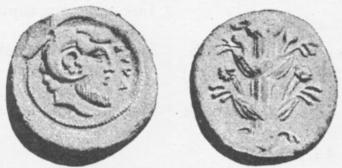
| Silphium ΚΥ. | Incuse square. Head of Zeus Ammon, of early transitional style, in dotted circle. AR Euboic tetradr. 248.4 grs. |
| Silphium. | Incuse circle. ΚΥΡΑ, Id. (Fig. 385) AR Euboic tetradr. 265 grs. |
| Id. | Id. AR Euboic didr. 124.8 grs. |
| Id. | Incuse square. Κ—Υ—Ρ—Α, Id. AR Phoenician dr. 52 grs. |
| Id. | Id. AR „ ½ dr. 25 grs. |
| Id. | Incuse square. Κ—Υ—Ρ—Α, Archaic head of nymph Kyrene with hair turned up under her diadem. AR 52 grs. |
| Female head (?). | Incuse square. Κ—Υ—Ρ—Α, Archaic head of Zeus Ammon. AR 11.8 grs. |
| Female head in wreath. | Incuse square. Head of Zeus Ammon. AR 11.8 grs. |
| Silphium | Incuse circle. Head of Zeus Ammon, in dotted square. AR 9.8 grs. |
In B.C. 431 the rule of the Battiadae was replaced by a republican form of government, under which Cyrene attained the highest point of her prosperity, as is sufficiently evident from the plentiful issue of fine gold pieces, as well as of silver tetradrachms in large numbers. The Euboic-Attic standard was now almost entirely abandoned in the case of the silver money for coins of the Phoenician weight of the Samian variety. Tetradr. 210-200 grs.
The gold coins, from the stater down to the half-drachm, were probably not issued much before B.C. 400, and follow the Euboic-Attic weight, but the smallest denominations are a piece of 13.5 grs., equivalent to one-tenth of the stater, a fraction which is also found in Cyprus, and a piece of 6.9 grs. (see Babelon, Traité, i. 422).
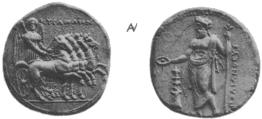
| ΚΥΡΝΑΙΟΝ Quadriga driven by Nike or Kyrene, sometimes surmounted by star, sometimes driven to front. | Zeus Ammon standing or enthroned, variously represented—holding eagle, Nike, and sceptre, sacrificing before thymiaterion (Fig. 386) or with ram, eagle, owl, or silphium beside him; magistrate’s name. AV Staters. |
| Κ—Υ—Ρ—Α—Ν Horseman. | Silphium; sometimes magistrate’s name. AV Dr. |
| Head of Athena | Three silphium plants radiating from one centre AV ½ Dr. |
| Beardless male head with ram’s horn, Aristaeos (?), or bearded head of Zeus Ammon, sometimes facing. | Female head, sometimes facing (Kyrene); Head of Libya with formal curls; or Ram’s head; magistrate’s initials. AV 1/10 Stater 13.5 grs. |
| Uncertain type. | Silphium. AV 1/20 Stater 6.9 grs. |
The magistrates’ names, which occur either in full or abbreviated form in the nominative or genitive case, are ΑΡΙΣΤΙΟΣ, ΑΡΙΣΤΑΓΟΡΑ, ΔΑΜΩΝΑΚΤΟΣ, ΘΕΥΦΕΙΔΕΥΣ, ΙΑΣΩΝ, ΙΑΣΟΝΟΣ, ΚΥΔΙΟΣ, ΚΥΘ, ΠΟΛΙΑΝΘΕΥΣ, ΧΑΙΡΕΦΩΝ, ΧΑΙΡΙΟΣ.
The silver coinage of Cyrene in this period consists in the main of tetradrachms of 210-200 grs.
| Head of Zeus Ammon, laur., diademed, or bare, and magistrate’s name. | Κ—Υ—Ρ—Α, etc., or no inscr. Silphium. [Müller, i, p. 45, No. 140.] AR Tetradr. |
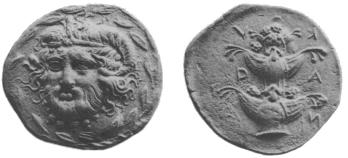
| Head of Zeus Ammon facing, all in laurel-wreath. | Κ—Υ—Ρ—Α—Ν—Α Silphium (Fig. 387). AR Tetradr. |
| ΚΥΡΑΝΑ Head of Zeus Ammon facing. [Z. f. N., vii, Pl..I. 17.] | Silphium, beside which a small gazelle on its hind legs, nibbling the topmost leaf. Magistrate, ΑΡΙΣΤΟΜΗΔΕΟΣ. AR Tetradr. |
The smaller denominations are drachms, ½ drachms, trihemiobols, and obols of the same standard. Types—Head of Zeus Ammon (on the obol, facing), or Youthful head with ram’s horn, or Head of Kyrene three-quarters r., rev. Silphium, or, on the trihemiobol, Triple silphium, on the obol, Head of Athena. (The silphium, in all denominations, is often on the obverse.)
The magistrates’ names on the silver coins are ΑΡΙΣΤΙΟΕ, ΑΡΙΣΤΟΜΗΔΕΟΣ, ΘΕΥΦΕΙ[ΔΕΥΣ], ΚΥΔΙΟΣ, ΛΙΒΥΣΤΡΑΤΟ[Σ], and ΝΙΚΙΟΣ, variously abbreviated. The following didrachms of Attic weight must also be classed to the latter part of this period.
| [ΦΕΙΔΩΝΟΣ retr.] Head of Apollo r.; behind quiver [Num. Chron., 1898, Pl. IX. 13.] | Incuse circle. ΚΥΡΑΝΑ (retr.) Silphium and palm-tree. AR 124 grs. |
| ΦΕΙΔΩΝΟΣ retr. Id. [Rev. Num., 1892, p. 506, Num. Chron., 1897, p. 220.] | ΔΑΜΩ Eros walking, singing to lyre. AR 130 grs. |
| ΘΕΥΦΕΙΔΕΥΣ Head of young Dionysos; behind, thyrsos. | ΚΥΡΑ Silphium. AR 130 grs. [Müller, No. 176.] |
| [ΠΟΛΙΑ]ΝΘΕΥΣ Young head with ram’s horn. | „ Id. AR 132 grs. [Müller, No. 142.] |
| ΠΟΛΙΑΝΘΕΥΣ Id. [Num. Chron., 1897, p. 221, Nos. 2, 3.] | Incuse circle. Hermes standing, holding caduceus, to which is attached taenia; behind, ΔΑΜΩ ΚΥΡΑΝΑ. AR 131 grs. |
The bronze coins of the same time exhibit, among others, the following types. Inscr. ΚΥΡΑ (or none at all):—
| Head of Zeus Ammon. | Silphium. Æ .85 |
| Head of nymph Kyrene. | Triple Silphium. Æ .85 |
| Head of Artemis, inscr. ΔΑΜΩ ΚΥΑΝΑ. | Nike. Æ .75 |
| Young head with ram’s horn. | Single or triple silphium. Æ .6 |
| Gazelle. | Silphium. Æ .75 |
| Head of Libya with formal curls. | Gazelle. Æ .55-.35 |
| Head of Zeus Ammon. | Wheel. Æ .9-.8 |
| Horseman or free horse. | Wheel. Æ .8-.5 |
| Bust of horse. | Wheel. Æ .9 |
In this period, while the Cyrenaïca was subject to Ptolemy Soter (B.C. 323-313 and 308-285) autonomous gold, silver, and bronze money was issued at Cyrene. The gold coins are of the Attic weight, but the silver, like some of the silver of Ptolemy, follows the Rhodian standard (Didr. 120 grs.). In addition, there were gold staters and half-staters of the ordinary Alexandrine types (which Svoronos assigns to the period B.C. 323-313), and, during the second period of Ptolemaic domination, gold, silver, and bronze with Ptolemaic types, often distinguished by the silphium, or by the monogram of Magas, who governed Cyrenaïca for his father-in-law Ptolemy Soter from B.C. 308. See Svoronos, Νομ. των Πτολ., Nos. 59 ff., 304 ff., and above, pp. 848, 850.
| Head of Athena, as on staters of Alexander. | ΚΥΡΑΝΑΙΟΝ (sometimes on the obv.) ΠΤΟΛΕΜΑΙΟΥ or ΠΤΟΛΕΜΑΙΩ. Nike standing, as on staters of Alexander. AV 133 grs. |
| Head of Athena. | ΠΤΟΛΕΜΑΙΟΥ or ΚΥΡΑΝΑΙΟΝ ΠΤΟΛΕΜΑΙ[ΟΥ?] Nike. Magistrate, ΕΥΦΡΙ. AV 67 grs. |
| Id. | ΠΤΟΛΕΜΑΙΟΥ Nike. Symbol, Wheel. AV 65 grs.
|
| Horseman; behind, star. [B. M. Guide, Pl. XXXV. 39.] | ΚΥΡΑ Silphium. AV 43.8 grs. |
| Head of Zeus Ammon. | Fulmen between two stars, star and monogram, or star and plough. AV 11.2 grs. |
| Id. | Head of nymph Kyrene. AV 11 grs. |
Of the above, the coins bearing the name Ptolemy (which is sometimes in the Doric genitive form) are assigned by Svoronos to the period B.C. 308-304, immediately following the suppression of the revolt of Ophellas.
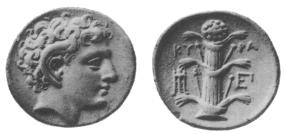
| Young head with ram’s horn (Fig. 388). | ΚΥΡΑ Silphium. Various symbols and monograms in field. AR Rhodian didr. 120 grs. |
| Head of Apollo, laureate. [B. M. Guide, Pl. XXXV. 41.] | ΚΥΡΑ Similar. AR 105 grs. |
| Head of Libya with formal curls. | ΚΥΡΑ Silphium. Æ .7 |
| Head of Zeus Ammon. | ΚΥΡΑ Palm-tree. Various symbols and letters. Æ .65 |
| Head of Apollo. | ΚΥΡΑ Lyre. Æ .65 |
| Id. | „ Prancing horse. Various symbols. Æ .65 |
In the reign of Ptolemy II (Philadelphus) bronze coins with the head of Libya were struck for Cyrene (Svoronos, op. cit., pp. 129-132, and above, p. 851); during the revolt of Magas (circa B.C. 283-271) Ptolemy’s name was erased on the coins, and sometimes replaced by that of Magas.
In B.C. 247 Ptolemy III (Euergetes) succeeded to the throne of Egypt, and by his marriage with Berenice, the daughter of Magas, who was queen in her own right of Cyrenaïca, united the diadems of Egypt and that country.
The evidence of the coins goes to prove that throughout the reign of Euergetes, whether owning to a successful revolt or not, the Cyrenaeans enjoyed an interval of autonomy, which did not cease until after his death. It was during this period that they sent to Megalopois in Arcadia to obtain the aid of the philosophers Demophanes and Ecdemus, who had assisted Aratus in the liberation of Sicyon from her tyrants.
These statesmen were entrusted with the government of the Cyrenaïca, which they appear to have reconstituted on the lines of the Achaean League. So much, at least, we may infer from the language of Polybius (x. 25) and Plutarch (Philop., i. 1), and from the Federal coins in silver and bronze, bearing the inscr. ΚΟΙΝΟΝ, which are probably to be attributed to this time, as the bronze pieces are often restruck on regal bronze of Ptolemy II.
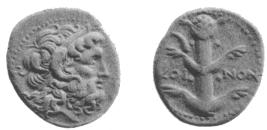
| Head of Zeus Ammon. | ΚΟΙΝΟΝ Silphium (Fig. 389). AR Didr. 118 grs. Æ .9-.7 |
From the accession of Ptolemy IV (Philopater) down to the death of Ptolemy Apion, B.C. 96, the coinage of Cyrenaïca is regal of the Ptolemaic type. It is described by Svoronos, Νομ. των Πτολεμαιων, and above, pp. 853 ff.
Ptolemy Apion, on his death (B.C. 96), left Cyrenaïca by his will to the Romans, who at first granted the various cities their freedom; but the disorders which arose compelled them soon afterwards to reduce that country to the condition of a Roman province (B.C. 74). Henceforth bronze coins only were issued in Cyrenaïca, and these bore the names of the Roman governors under Augustus — L. Lollius, A. Pupius Rufus, L. Fabricius Patellius, Scato, Palicanus, and Capito — with various titles in Greek or Latin characters, such as TAMAIC ANTICTPA[THΓOC], PROCOS, or Q[VAESTOR].
Among the types may be mentioned the Heads of Ammon, Apollo, Artemis, or the Emperor, Helmeted female head (ΡΩΜΗ?), Curule chair, Camel, Stag, Ram, Bee, Caduceus, Wreath, Serpent, &c. Svoronos Νομ. των Πτολ., Nos. 1899-1904) also plausibly attributes to Cyrenaïca Æ of M. Antonius and Cleopatra, as well as Æ of P. Canidius Crassus.
There are also later Imperial coins of Titus, Trajan, Faustina Senior, M. Aurelius, and Severus Alexander, attributed conjecturally to Cyrenaïca (Müller, i, p. 171), but the evidence for the Cyrenaïc origin of these is very doubtful.
Barce was founded from Cyrene about the middle of the sixth century. Its coinage down to the age of the Ptolemies falls into the same periods as that of Cyrene. In the archaic period it is generally impossible to distinguish the issues of Barce from those of Cyrene, as they are, as a rule, uninscribed. In the fifth century (B.C. 480-431), while Barce, like Cyrene, was governed by kings, its coinage consists of Euboic-Attic
| Silphium | Head of Zeus Ammon. AV 26.4 grs. |
This gold coin is attributed to Barce simply on account of the style of the head of Ammon, which closely resembles that of some of the inscribed tetradrachms of the town.
| Head of Zeus Ammon in profile. | Silphium, sometimes accompanied by two jerboas (Müller, 318) or by a gazelle recumbent (Z. f. N., vii, Pl. I. 18), or by an owl (Müller, 324). AR Tetradrachm. 200 grs. |
| Head of Zeus Ammon, facing. | Single or triple silphium, the latter accompanied by accessory symbols, chameleon, owl, and jerboa, in field. AR Tetradr. 198.3 grs. |
| Young head with ram’s horn. [Fox, Gr. C., Pt. II, Pl. VIII. 167.) | Silphium. AR 160 grs. |
| Id. | Id. AR 49.5 grs. |
| Id. | Id. AR 24.4 grs. |
| Triple silphium | Head of Zeus Ammon. AR 15 grs. |
Magistrates’ names on the coins of Barce, ΑΚΕΣΙΟΣ, ΦΑΙΝ, ΚΑΙΝΙΩ, ΚΥΨΕΛΩ ΤΩ ΦΙΛΩΝ (=ΚΥΨΕΛΟΥ ΤΟΥ ΦΙΛΩΝ[ΟΣ]).
The bronze coins resemble those of Cyrene; obv. Horseman, rev. Wheel; symbol, silphium (Müller, i, p. 82).
Under the rule of the Ptolemies Barce was eclipsed by its port, which received the name of Ptolemaïs (q.v.).
Euesperides, said to have been founded from Cyrene circ. B.C. 460, was the farthest to the west of the five cities of Cyrenaïca. It stood at the mouth of a river called Lathon or Lethon.
| ΕΣ Silphium. | ΕΥ Dolphin and two pellets in incuse square. AR 48.6 grs. |
| Silphium. | V or FV [1] Incuse square, containing dolphin and hoof of fawn (?) AR ½ Drachm.
|
1 This inscription suggests that this coin belongs not to Euesperides but to some city whose name begins with Υ (Hydrax?).
| Silphium. | ΕΥ (?) Incuse circle, within which dolphin and crab’s claw. AR ½ Drachm. |
| Silphium. | ΕΥΕΣ Incuse square, within which head of Zeus Ammon in circle of dots. AR Dr. 52 grs. AR ½ Dr. 27 grs. |
The only tetradrachm of Euesperides as yet known is in the library at Turin.
| Head of Zeus Ammon r. surrounded by a triple circle. | ΕΥΕΣΠΕΡΙΤΑΝ Silphium. [Z. f. N., vii, p. 30.] AR 193 grs. |
To the end of the Republican period, shortly before the conquest of the country by Ptolemy Soter, may be ascribed the following Attic didrachm in the De Luynes Collection. The bronze coins with the head of the same River-god seem to be somewhat earlier.
| ΕΣΠΕΡΙ... Young horned head of river Lathon, wearing wreath. | ΤΙΜΑΓΟΡΑ Deer before silphium. AR Didr. 130 grs. |
| ΑΗΘΩΝ or ΑΗΤΩΝ Head of river-god. | ΕΥ Silphium. Æ .7 |
| Head of Zeus Ammon. | ΕΥ Trident. Æ .8 |
Under the Ptolemies the name of Euesperides was changed to Berenice.
Ptolemaïs. To this city the following bronze coin of P. Canidius Crassus, lieutenant of M. Antonius, has been attributed.
| ΠΤΟΛΕΜΑΙ Turreted head of City. | ΚΡΑΕ Crocodile. [Svoronos, Nομ. των Πτολ., No. 1901, Pl. LXIII. 27, 28.] Æ 1.25 |
Teuchira, between Ptolemaïs and Euesperides, received under the Ptolemies the name of Arsinoë.
| Τ Ε Silphium. [Bompois, op. cit., Pl. I. 10.] | Head of Zeus Ammon in incuse circle. AR Dr. 52 grs. |
For coins attributed to other cities of Cyrenaïca (Sozusa, Balagrae, Heraclea ?) see Müller, pp. 93 f.